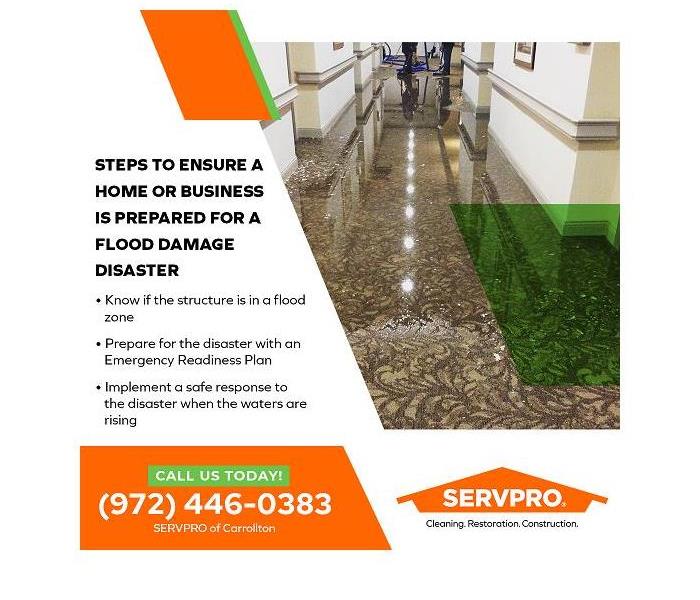How a Knowledge of Flood Zone Mapping Helps Homeowners Prepare for Flood Damage
9/7/2022 (Permalink)
Blog Summary: SERVPRO of Carrollton explains flood zones to help homeowners prepare for flooding due to storms.
SERVPRO® of Carrollton is a leading provider of flood restoration services for Carrollton, TX, and surrounding communities. With years of experience and the combined efforts of other franchise members, SERVPRO can scale immediately to handle any size disaster, including widespread flood damage.
Below are three steps to ensure a home or business is ready when disaster strikes:
Step #1. Know if the structure is in a flood zone.
Step #2. Prepare for the disaster with an Emergency Readiness Plan.
Step #3. Implement a safe response to the disaster when the waters are rising.
The first and most crucial aspect of flood damage preparation is assessing the degree of actual risk. Preparation in a low-risk flood zone will be much less involved than preparation in a high-risk zone.
When assessing the flood damage risk hazard, two main questions must be answered:
- Is the structure in a flood zone?
- If so, what are the risk hazards in the flood zone?
Understanding flood zones
Every structure is in a flood zone, but risk levels range from low to moderate to high. Flood zones, which are areas of land designated by FEMA (Federal Emergency Management Agency), are each assigned a specific flood risk. Designation as a specific flood zone is not haphazard; the assignment is based on careful research and analysis. It is imperative for homeowners or business owners to know the flood zone in which their property is located. A full understanding of the risk hazard will have a profound impact on the Emergency Readiness Plan, the survival plan, the response strategy when the waters are rising, and the recovery protocol. Preparation, response, and recovery are crucial components in mitigating the risk.
Finding a flood zone
Homeowners and businesses can search for their flood zone using the FEMA Flood Map Service Center. Type in an address, location, or specific coordinates in the search engine and click on "search." The results will open on a new page with various options to further drill down into the data.
How flood risks are determined
FEMA conducts a Flood Insurance Study to ascertain the flood risk for a designated area. Statistical data from the following items go into this analysis:
- river flow
- storm tides
- hydrologic and hydraulic analyses
- rainfall and topographic surveys
From this mountain of data, flood hazard maps are generated for communities throughout the United States. Location in a floodplain and frequent exposure to strong coastal storms or monsoons constitute high-risk areas. Communities that are located away from the coastal regions or that are at high altitudes may be rated at minimal risk for flooding.
Why flood zone mapping is crucial for preparation, response, and recovery
- Flood zone mapping is indispensable for determining what flood insurance is needed to cover the related risk.
- Flood zone mapping comes into play when purchasing a property. If a piece of real estate is located in a floodplain and is at high risk of flood damage, the selling price should reflect the extreme risk hazard. The cost of flood insurance may drive the expense of owning the property astronomically high. ROI may be impossible to recoup. A series of floods may also render the property impossible to sell at any price.
- If the home is known to be in a high-risk area for flooding, readiness at all times is the key to survival. When severe flooding strikes a community, travel can be impossible. Life in a high-risk zone necessitates the identification of multiple evacuation routes in case a bridge or road washes out. A shelter-in-place strategy is in order if only minutes are available to respond in a real-life scenario when flood waters are raging downstream or down a mountainside.
Power and water may be offline for days or weeks. Potable water may be unobtainable for days unless stockpiles are in place to sustain the members of the household for an extended period of time. A generator, stored fuel, stockpiles of food, ample medical supplies, and medications, several field water filters, a large reserve of batteries, a solar-powered charger, and multiple cell phones will be essential items. Living in a high-risk flood zone means living with the inevitable. This realization impacts the items stockpiled, the stockpile location, quantities, storage methods, and quality of food stores.
When the waters recede
Recovery is a crucial third phase of the Emergency Readiness Plan. The time to choose a property damage restoration company to deal with the mud, debris, water, structural damage, and mold is before disaster strikes. By working with SERVPRO of Carrollton, homeowners and businesses have access to decades of training, expertise, and experience in the cleanup and restoration of flood damage and storm damage disasters.
Contact SERVPRO of Carrollton to learn more about flood damage restoration in and around Farmers Branch, TX. The office can be reached by calling (972) 446-0383 or by emailing office@SERVPRO10952.com

 24/7 Emergency Service
24/7 Emergency Service
